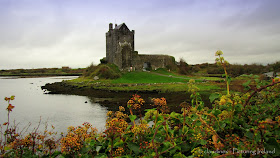If the walls of this picturesque medieval tower house could speak, they would tell a colourful tale of Kings and Mayors, well-known poets and the Celtic Revival Movement at the beginning of the 20th century.
(runterscrollen für deutsche Version)
The castle sits on the scenic shore of Galway Bay just a stone throw away from the little village of Kinvara along the Wild Atlantic Way.
The name Dunguaire means the "fortress of Guaire". It refers to the legendary King of Connacht Guaire Aidne mac Colmain, who built his royal palace at this site in the 7th century.
The current castle was built in 1520 by the Hynes Clan, who were descendants of King Guaire. Near the castle are remnants of a ring fort, also believed to have been built by the Hynes Clan.
The Hynes held on to the castle until 1642, when it was sold to the then-Mayor of Galway, Richard Martyn. He began to modernize the old tower house and equipped it with glass windows and chimneys. The Martyns later moved their family seat to Tulira Castle near Gort in Co. Galway and Dunguaire Castle fell into disrepair.
 |
| The remains of an ancient ring fort |
In 1924 the castle was purchased by one of the most eccentric and colourful figures of the Irish literary scene, the poet, playwright and politician Oliver St. John Gogarty. He was friends with James Joyce, who actually based the character of Buck Mulligan in the novel "Ulysses" on St. John Gogarty.
St. John Gogarty renovated the castle and turned it into a meeting place for the Irish Literary and Celtic Revival Movement. One of the leaders of that movement was Lady Gregory, who lived close by, in Coole Park in County Galway. She brought people like J.M. Synge, George Bernard Shaw and William Butler Yeats, who also happend to live just down the road in his own medieval tower house castle Thoor Ballylee.
In 1954, the castle changed hands again. It was purchased by Lady Christabel Ampthill, who finished the renovations started by Oliver St. John Gogarty.
Today, it is owned by the Shannon Development agency, which hosts Medieval Banquets here in the summer months. Guests are treated to a five-course medieval feast and entertained by songs and poems from bards like St. John Gogarty, W.B. Yeats and J.M. Synge.
If only these walls could talk...!
German version:
Wenn die Mauern dieses mitteralterlichen Turmschlosses sprechen könnten, würden sie eine lebhafte Geschichte von Königen und Bürgermeistern, Dichtern und der Keltischen Renaissance Bewegung Anfang des 20. Jahrhunderts erzählen.
Das Schloss liegt an der malerischen Küste von Galway Bay, nur einen Steinwurf entfernt vom kleinen Dorf Kinvara entlang des Wild Atlantic Way.
Der Name Dunguaire bedeutet "die Festung von Guaire" und bezieht sich auf den legendären König von Connacht Guaire Aidne mac Colmain, der im 7. Jahrhundert hier seine royalen Palast errichtet hat.
Das Schloss, das heute hier steht, wurde anno 1520 vom Hynes Clan erbaut, ihres Zeichens Nachfahren von König Guaire. In der Nähe des Schlosses sieht man noch die Überreste eines Ringforts, das auch vom Clan der Hynes Clan errichtet worden sein soll.
Die Hynes Familie hielt das Schloss bis 1642 in ihrem Besitz, bis sie es an den damaligen Bürgermeister der Stadt Galway, Richard Martyn verkauften. Er begann die alten Mauern zu modernisieren und baute Glasfenster und Kamine ein. Die Martyns verlegten ihren Familiensitz später ins Tulira Castle nahe Gort in der Grafschaft Galway und Dunguaire Castle fiel in einen Dornröschen Schlaf und verwahrloste im Lauf der Zeit.
Anno 1924 wurde das Schloss von einer der exzentrischsten Persönlichkeiten der irischen Literaturszene erworben - dem Dichter, Dramatiker und Politiker Oliver St. John Gogarty. Er war ein Freund von James Joyce, der sogar die Figur Buck Mulligan im Roman Ulysses nach St. John Gogarty modellierte.
St. John Gogarty renovierte das alte Schloss und verwandelte es in einen Treffpunkt der irischen Literaten der keltischen Rennaissance Bewegung. Eine der wichtigsten Vertreter dieser Bewegung war Lady Gregory, die nicht weit entfernt, in Coole Park in der Grafschaft Galway lebte. Sie brachte literarische Größen wie J.M. Synge, George Bernard Shaw and William Butler Yeats vorbei,
der übrigens selbst ganz in der Nähe sein eigenes kleines Turmschloss in Thoor Ballylee bewohnte.
Im Jahr 1954 wechselte das Schloss abermals den Besitzer. Es wurde von Lady Christabel Ampthill erworben, die St. John Gogarty's Renovierungen fortsetzte.
Heute ist das Schloss im Besitz der Agentur Shannon Development, die in den Sommermonaten mittelalterliche Bankette veranstaltet. Die Gäste erwartet ein fünfgängiges mittelalterliches Menü, sowie Unterhaltung in Form von Musik und Dichtkunst von Barden wie St. John Gogarty, W.B. Yeats und J.M. Synge. Wenn diese Mauern nur sprechen könnten...!
 |
| Galway Bay |










This information is really good and helpful.I am feel very happy after read your blog.It is really helpful for new people.Thank for sharing this blog with us.
ReplyDeleteurbanest melbourne city